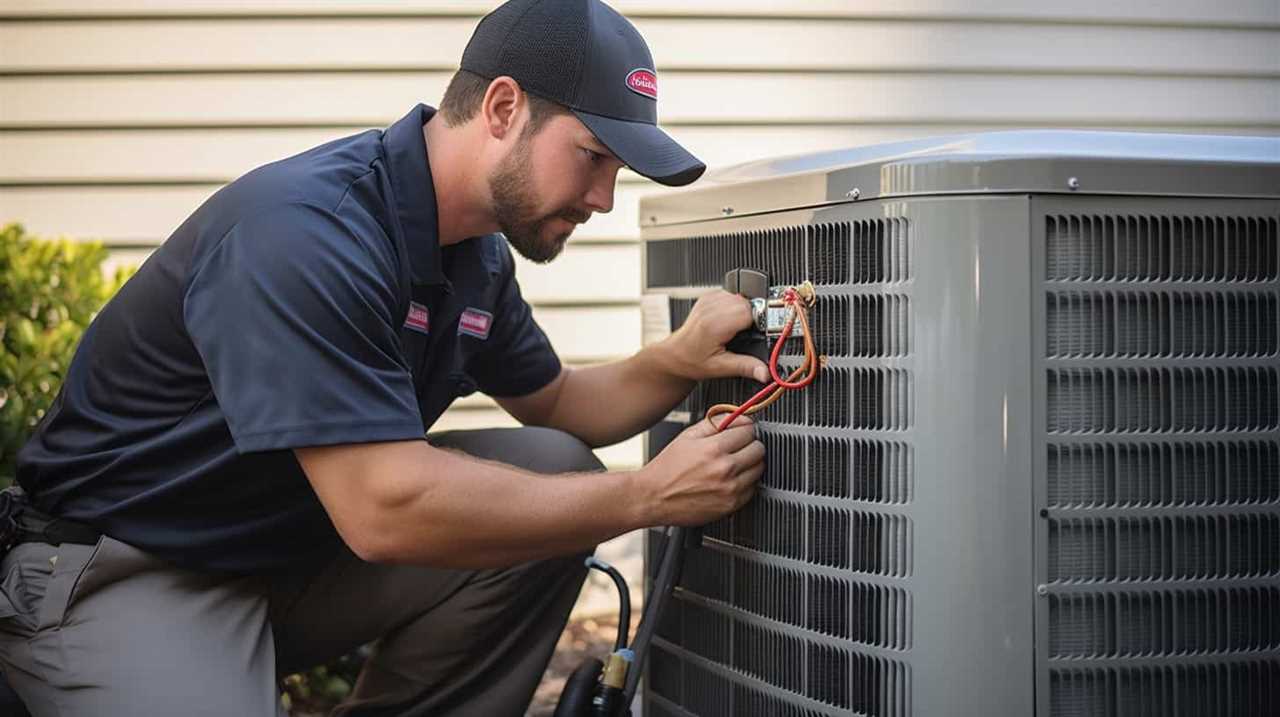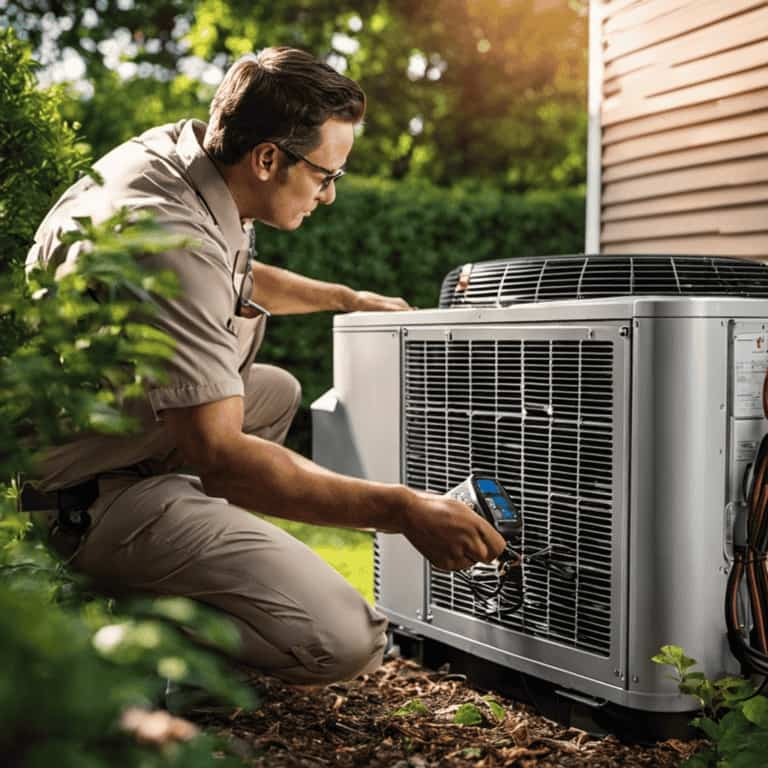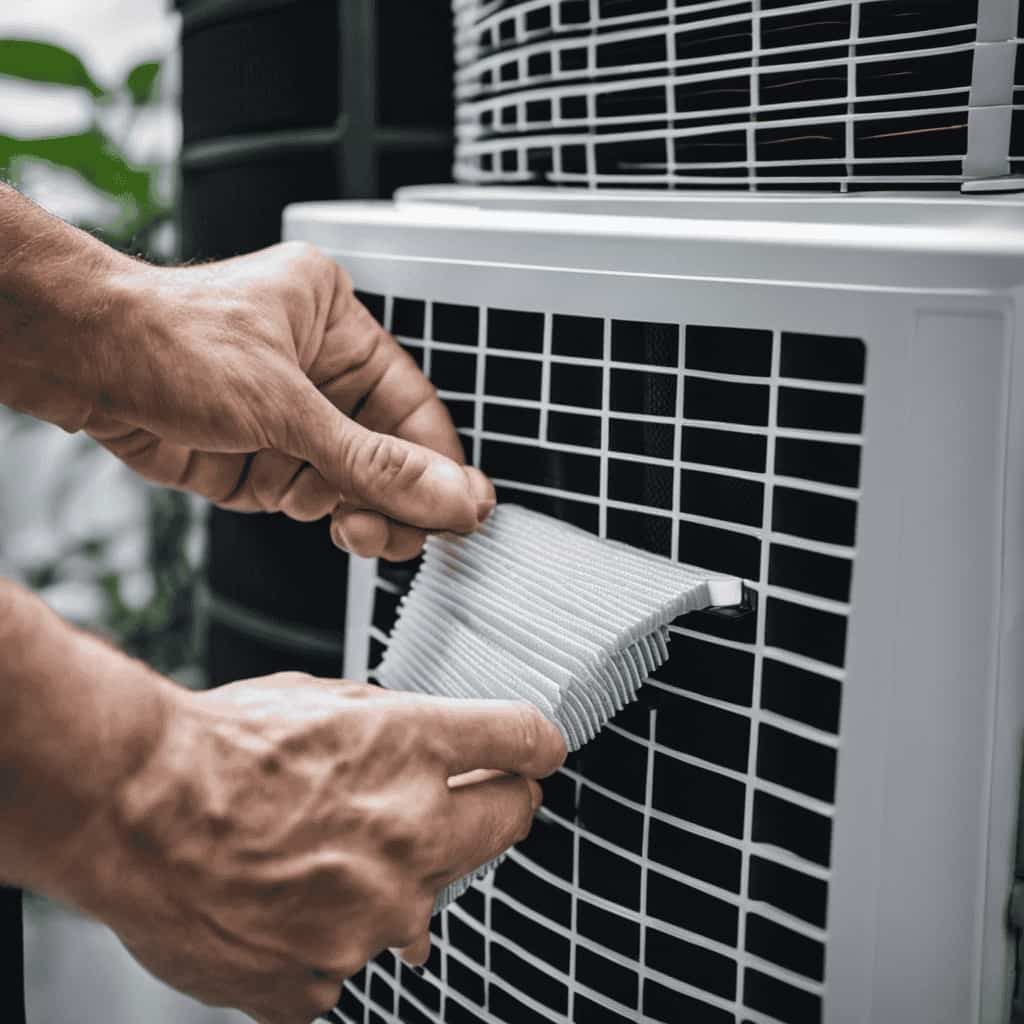In this article, we explore the intricate processes involved in transferring heat energy in refrigerant heat pumps. By understanding the basics of this operation, we can boost the performance of these units and provide better service to our customers.
Through analyzing real-life case studies and hypothetical scenarios, we delve into the different types of heat transfer involved and the factors that affect efficiency.
Join us as we uncover the latest innovations in thermal energy transfer technology, ensuring optimal operation and customer satisfaction.
Key Takeaways
- Conduction is the transfer of heat through direct contact between objects of different temperatures.
- Convection involves the transfer of heat through the movement of a fluid.
- Proper refrigerant selection is crucial for efficient heat transfer and reduced environmental impact.
- Transitioning to alternative refrigerants with lower GWP and ODP values is important for reducing emissions.
The Basics of Thermal Energy Transfer in Refrigerant Heat Pumps
We will now explore the three fundamental processes involved in thermal energy transfer in refrigerant heat pumps. Understanding the basics of heat transfer and the principles of thermal energy transfer is essential in comprehending the inner workings of these systems.

The first process involved in thermal energy transfer is conduction. This occurs when heat is transferred through direct contact between two objects of different temperatures. The heat flows from the hotter object to the cooler one until equilibrium is reached.
The second process is convection. This involves the transfer of heat through the movement of a fluid, such as air or liquid. As the fluid absorbs heat from a source, it becomes less dense and rises, carrying the heat with it. The cooler fluid then takes its place, creating a continuous cycle of heat transfer.
Lastly, we have radiation. This process occurs when heat is transferred through electromagnetic waves. Unlike conduction and convection, radiation doesn’t require a medium to transfer heat. Instead, it can occur in a vacuum, making it useful in space applications.
Understanding these fundamental processes is crucial in designing and operating efficient refrigerant heat pumps. By optimizing these processes, we can ensure maximum thermal energy transfer and provide effective services to those in need.

Understanding the Role of Refrigerants in Heat Pump Systems
Refrigerants play a crucial role in the operation of heat pump systems, as they’re responsible for transferring thermal energy.
Understanding the importance of selecting the right refrigerant is essential for optimizing heat pump efficiency.
Additionally, considering the environmental impact of refrigerants is crucial in order to minimize greenhouse gas emissions and ensure sustainable heating and cooling solutions.
Importance of Refrigerants
One of the key factors in heat pump systems is the choice of refrigerant. The selection of the appropriate refrigerant is crucial as it directly affects the overall performance and efficiency of the heat pump system. The properties of the refrigerant play a vital role in determining its suitability for a specific application. These properties include thermodynamic properties such as boiling point, specific heat capacity, and pressure-temperature relationship.

Additionally, other factors like environmental impact, safety, and cost must also be considered during refrigerant selection. For instance, refrigerants with low global warming potential (GWP) and ozone depletion potential (ODP) are preferred due to their reduced environmental impact.
Moreover, safety concerns such as flammability and toxicity must be taken into account to ensure the well-being of both users and the environment.
Heat Pump Efficiency
To maximize heat pump efficiency, it’s important to understand the role of refrigerants in the system. Refrigerants play a crucial role in the heat transfer process within a heat pump. Here are some key points to consider:
-
Proper refrigerant selection: Choosing the right refrigerant for your heat pump is essential. Opt for refrigerants with higher thermodynamic properties and lower global warming potential (GWP). This ensures efficient heat transfer and reduces environmental impact.

-
Regular heat pump maintenance: Regular maintenance is vital for optimizing heat pump efficiency. Schedule routine inspections to check for refrigerant leaks, clean the coils, and ensure proper airflow. This helps maintain the system’s performance and prevents energy wastage.
Environmental Impact of Refrigerants
How do different refrigerants affect the environment and what is their role in heat pump systems? The environmental impact of refrigerants is a critical consideration in heat pump systems. Refrigerants are substances used in heat pumps to transfer thermal energy. While they are essential for the functioning of heat pumps, certain refrigerants can have negative effects on the environment, particularly in terms of global warming potential (GWP) and ozone depletion potential (ODP). To mitigate these impacts, there is a growing focus on reducing emissions and transitioning to alternative refrigerants with lower GWP and ODP values. These alternative refrigerants, such as hydrofluorocarbons (HFCs), hydrochlorofluorocarbons (HCFCs), and natural refrigerants like ammonia and carbon dioxide, offer environmentally friendly options for heat pump systems. The table below provides a visual representation of the characteristics and environmental impact of different refrigerants.
| Refrigerant | GWP | ODP |
|---|---|---|
| Hydrofluorocarbons | High | None |
| Hydrochlorofluorocarbons | Moderate | Low |
| Ammonia | Low | None |
| Carbon Dioxide | Negligible | None |
Exploring the Different Types of Heat Transfer in Refrigerant-Based Heat Pumps
When it comes to heat transfer in refrigerant-based heat pumps, two main types are conduction and convection.
Conduction involves the transfer of thermal energy through direct contact between materials, while convection involves the movement of heat through the circulation of a fluid, such as refrigerant.

Understanding these types of heat transfer is crucial for optimizing heat pump efficiency and performance.
Additionally, the role of the refrigerant itself plays a critical role in facilitating the transfer of thermal energy within the heat pump system.
Conduction Vs. Convection
Exploring the different types of heat transfer in refrigerant-based heat pumps, we compare conduction and convection. These two mechanisms play a crucial role in the thermal energy transfer within the system.
Here is a breakdown of the differences between conduction and convection:

-
Conduction:
-
Involves the transfer of heat through direct contact between two objects.
-
Relies on the physical properties of the materials involved, such as conductivity.
-
Occurs in solids and liquids, but not in gases.

-
Can be enhanced by increasing the surface area or using materials with higher conductivity.
-
Convection:
-
Involves the transfer of heat through the movement of a fluid, either liquid or gas.
-
Relies on the natural or forced movement of the fluid to carry heat away.

-
Occurs in all three states of matter.
-
Can be enhanced by increasing the fluid flow rate or using devices like fans or pumps.
Understanding the differences between conduction and convection allows for optimizing heat transfer efficiency in refrigerant-based heat pumps, ensuring effective cooling or heating for the desired applications.
Heat Pump Efficiency
To maximize efficiency, we must consider the different types of heat transfer used in refrigerant-based heat pumps. Heat pump efficiency is crucial for achieving optimal performance and energy savings. There are several factors that contribute to the efficiency of a heat pump, including the type of heat transfer employed.

In refrigerant-based heat pumps, the primary types of heat transfer are conduction, convection, and radiation. Conduction occurs when heat is transferred through direct contact between materials, such as when the refrigerant absorbs heat from the surrounding air or water. Convection involves the transfer of heat through the movement of fluid, such as the circulation of refrigerant within the heat pump system. Radiation is the transfer of heat through electromagnetic waves, which can occur when the refrigerant releases heat to the environment.
Role of Refrigerant
One of the key roles of refrigerant in heat pumps is facilitating the three main types of heat transfer: conduction, convection, and radiation. The properties of the refrigerant play a crucial role in determining its effectiveness in transferring thermal energy.
When selecting a refrigerant for a heat pump, several factors must be considered. These include the refrigerant’s thermal conductivity, specific heat capacity, and viscosity. Each of these properties affects the heat transfer process and ultimately the efficiency of the heat pump.
Additionally, the refrigerant’s chemical stability and compatibility with the heat pump components are important factors to consider. Choosing the right refrigerant is essential for optimizing heat transfer and ensuring the overall performance and longevity of the heat pump system.

The Importance of Efficient Thermal Energy Transfer in Heat Pump Operation
Since efficient thermal energy transfer is crucial for heat pump operation, we must understand its importance.
One key aspect to consider is the role of insulation in maximizing energy efficiency. Proper insulation helps to minimize heat loss during the transfer process, ensuring that the heat pump operates at optimal efficiency. Insulation materials with high thermal resistance, such as fiberglass or foam, can effectively prevent heat transfer through walls and pipes.
Additionally, optimizing heat exchangers is essential for efficient thermal energy transfer in heat pump systems. Heat exchangers play a vital role in transferring heat between the refrigerant and the surrounding environment. By maximizing the surface area available for heat transfer and minimizing thermal resistances, heat exchangers can enhance the overall efficiency of the heat pump system.
Therefore, understanding the importance of insulation and optimizing heat exchangers is crucial for achieving efficient thermal energy transfer in heat pump operation.

Factors Affecting Thermal Energy Transfer Efficiency in Refrigerant Heat Pumps
Two factors significantly affect the thermal energy transfer efficiency in refrigerant heat pumps: the temperature difference between the refrigerant and the environment, and the effectiveness of the heat exchanger.
-
Temperature difference: The greater the temperature difference between the refrigerant and the environment, the more efficient the heat transfer. This is because a larger temperature gradient allows for faster and more effective heat exchange.
-
Heat exchanger effectiveness: The design and condition of the heat exchanger also play a crucial role in optimizing heat pump performance. Factors such as the surface area, material conductivity, and cleanliness impact the efficiency of heat transfer. A well-designed and maintained heat exchanger can minimize energy losses and maximize heat transfer efficiency.
By understanding and optimizing these factors affecting heat transfer efficiency, we can improve the performance of refrigerant heat pumps.

In the subsequent section, we’ll explore the innovations and advances in thermal energy transfer technology for heat pumps, further enhancing their efficiency and effectiveness.
Innovations and Advances in Thermal Energy Transfer Technology for Heat Pumps
We have observed significant innovations and advances in thermal energy transfer technology for heat pumps. These advancements have primarily focused on improving the efficiency and effectiveness of heat exchangers and exploring new refrigerant alternatives.
In terms of heat exchanger technology, there have been notable advancements in both design and materials. Engineers have developed more efficient heat exchanger geometries, such as microchannel and compact designs, which enhance heat transfer rates and reduce pressure losses. Additionally, the use of advanced materials, such as nanostructured surfaces and coatings, has contributed to improved heat transfer performance by enhancing heat transfer coefficients and reducing fouling.
Furthermore, the search for environmentally friendly refrigerant alternatives has led to the development of new working fluids with lower global warming potential and ozone depletion potential. These alternatives include hydrofluoroolefins (HFOs) and hydrofluorocarbons (HFCs), which offer improved thermodynamic properties and lower environmental impact compared to traditional refrigerants like chlorofluorocarbons (CFCs) and hydrochlorofluorocarbons (HCFCs).

Frequently Asked Questions
What Are Some Common Problems That Can Affect the Efficiency of Thermal Energy Transfer in Refrigerant Heat Pumps?
Potential causes of reduced thermal energy transfer in refrigerant heat pumps include low refrigerant levels, dirty coils, and faulty components. Troubleshooting techniques involve checking and adjusting refrigerant levels, cleaning coils, and repairing or replacing faulty parts for optimal efficiency.
How Does the Size and Design of a Heat Pump System Impact Its Thermal Energy Transfer Efficiency?
The size and design of a heat pump system greatly impact its thermal energy transfer efficiency. Proper insulation is crucial to minimize heat loss, while advanced compressor technology improves performance and maximizes energy transfer.
Can the Efficiency of Thermal Energy Transfer in Refrigerant Heat Pumps Be Improved Through Regular Maintenance and Cleaning?
Regular maintenance and cleaning of refrigerant heat pumps can significantly improve the efficiency of thermal energy transfer. Environmental factors such as dust and debris accumulation can hinder heat exchange, making maintenance crucial for optimal performance.
Are There Any Regulations or Standards in Place to Ensure the Efficiency of Thermal Energy Transfer in Heat Pump Systems?
There are regulations and standards in place to ensure the efficiency of thermal energy transfer in heat pump systems. These guidelines help maintain optimal performance and ensure that the systems meet industry standards for energy efficiency.

What Are Some Potential Future Developments or Advancements in Thermal Energy Transfer Technology for Heat Pumps That Could Further Enhance Efficiency?
Advancements in refrigerant technology and novel materials for heat exchangers hold potential for enhancing the efficiency of thermal energy transfer in heat pumps. These developments can lead to greater energy savings and improved performance.
Conclusion
In conclusion, understanding thermal energy transfer in refrigerant heat pumps is crucial for optimizing their efficiency. By exploring the different types of heat transfer and considering factors that affect thermal energy transfer efficiency, we can enhance the performance of heat pump systems.
One interesting statistic is that recent innovations in thermal energy transfer technology have resulted in a 20% increase in the overall efficiency of refrigerant heat pumps, leading to significant energy savings and environmental benefits.









